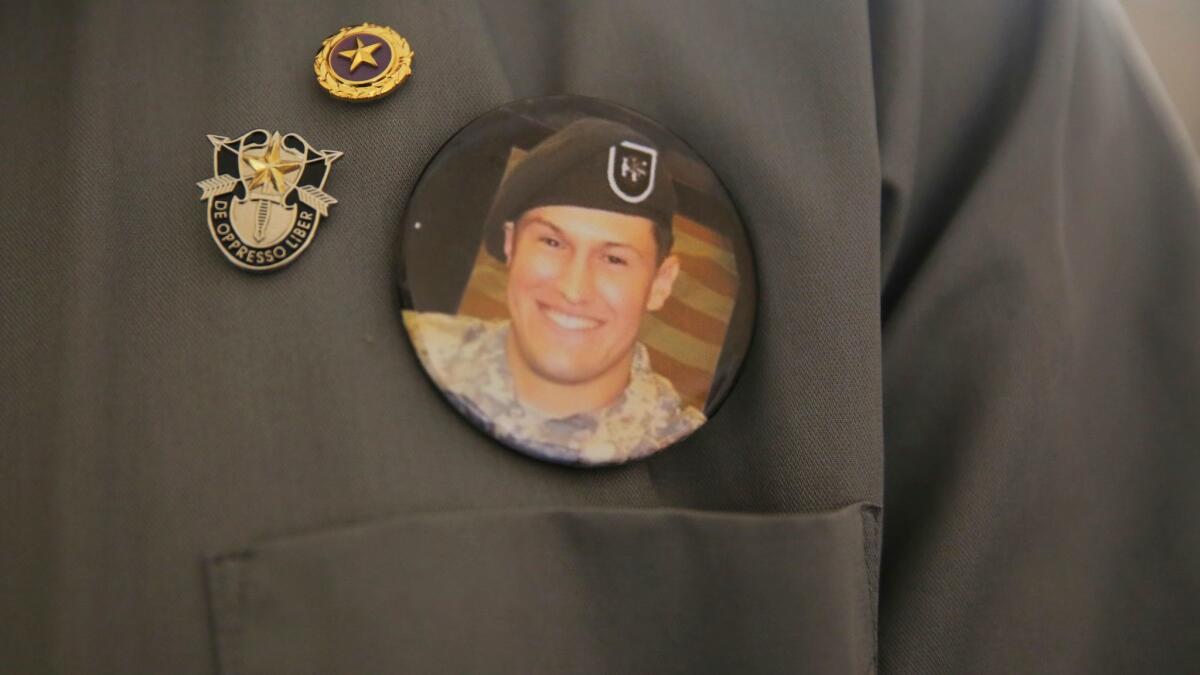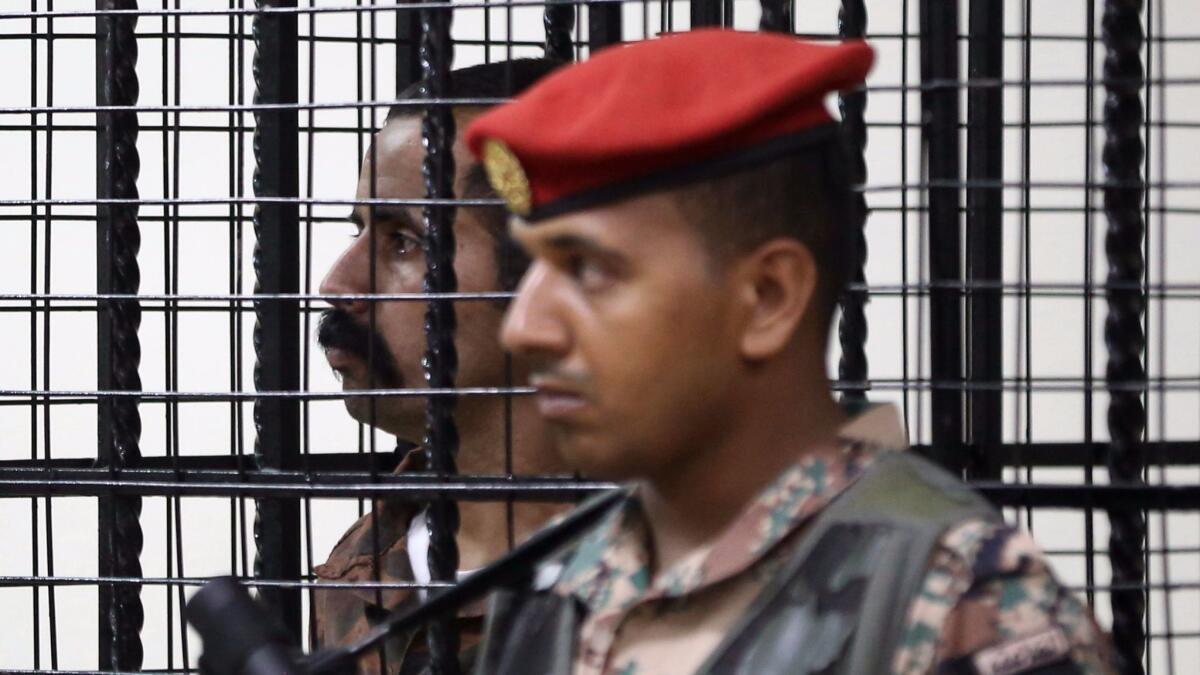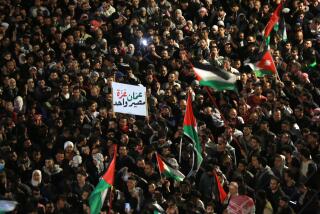Jordan releases video to tamp down support for Green Berets’ killer
- Share via
Reporting from AMMAN, Jordan — When a military court sentenced a Jordanian soldier to life imprisonment this month for killing three U.S. Special Forces soldiers in November, many in the country saw the verdict as a capitulation to the demands of U.S. authorities. They insisted the soldier, 1st Sgt. Maarek Abu Tayeh (also known as Tawayha), was a “hero” who was just doing his duty, and held protests demanding his release.
But on Monday, Jordan’s army released security camera images of the incident, which showed a six-minute hunt in which Abu Tayeh stalked the lightly armed Green Berets, despite repeated attempts by the Americans to show they were friendly.
Three soldiers, Staff Sgts. Matthew C. Lewellen, 27; Kevin J. McEnroe, 30; and James F. Moriarty, 27, were killed in the shooting at the King Faisal air base in the area of Jafr, in the south of Jordan. The incident left the government in Amman struggling to justify Abu Tayeh’s actions to its U.S. ally even as an FBI and Special Operations Command investigation rebuffed Jordanian explanations.
Jordanian officials had initially blamed the American troops for not stopping at the base’s gate and properly identifying themselves, with some going so far as to say the Green Berets had been drunk.
A later version of events said that Abu Tayeh had fired after hearing a gunshot and that the fire exchange “was quickly halted upon knowing that friendly U.S. members were on the other side,” according to a letter addressed to Rep. Ted Poe (R-Texas) by Jordan’s ambassador to Washington, Dina Kawar, in March.
The video, which was previously shown to the U.S. as well as to the parents of the slain soldiers, contradicts both accounts.

It opens with a four-vehicle convoy bearing the Americans rolling to a halt after passing a gate that is opened and closed by a Jordanian soldier.
The first sign anything is wrong comes when bullets fired from off-camera strike a white pickup with the Americans inside. Two soldiers, Moriarty and an unnamed Green Beret, run out of the third and fourth vehicles in the convoy and take cover behind concrete barriers. They pop their heads to shout at Abu Tayeh, waving their arms above their heads (at one point for a full 14 seconds) to stop his attack.
When the Americans run to another set of barriers, Abu Tayeh runs up to them armed with an M-16 and wearing a bulletproof vest. As he raises his rifle to shoot, Moriarty pops up with a pistol and fires a bullet before being cut down. It gives the other Green Beret the time needed to swing around the concrete barrier and shoot Abu Tayeh in the neck, critically wounding him.
Other Jordanian soldiers seen in the video run away and hide during the gun battle, while other vehicles approaching the base appear to be unaware of the firefight.
The video does not show what first spurred Abu Tayeh to attack. It has no sound and is recorded from a vantage point that keeps Abu Tayeh obscured for most of its duration.
The Green Berets were involved in a training program for Syrian rebels.
A public version of a Special Operations Command report on the investigation denied there had been any alcohol and said the Americans had followed protocol.
Abu Tayeh was sentenced to life in prison with hard labor last week. Because no links were found to terrorist entities, he was charged as a criminal, meaning he could not be given the death penalty under Jordanian law. Nevertheless, he insisted he was not guilty and had been acting in self-defense. (This despite having fired 63 rounds of his M-16 at the Americans, who were armed only with pistols, according to the report.)

Investigators have been unable to explain Abu Tayeh’s motivations. On the day of the sentencing last week, Moriarty’s father, Jim R. Moriarty, said in a phone interview from Amman that he knew “less about what happened today than I knew the day it happened.”
He blamed Jordan for lying “repeatedly” about the incident.
Protests erupted in the south of Jordan after the verdict, with relatives of Abu Tayeh, who is a member of the Howeitat tribe, demanding that Jordan’s King Abdullah II set him free.
The Howeitat is an important tribe in the country; its onetime leader, Auda Abu Tayeh, figured prominently in Col. T.E. Lawrence’s “Seven Pillars of Wisdom” as well as David Lean’s movie, “Lawrence of Arabia.”
Members of the tribe insisted Abu Tayeh had acted in self-defense even after the video’s release, saying on the Howeitat Facebook page that they were proud “of the hero Maarek who defended the base while others hid.”
They vowed Abu Tayeh would be released.
But a damning statement from the Jordanian armed forces released early Tuesday confirmed that Abu Tayeh had “violated the military orders and instructions that are in place at the entrances of bases.”
It added that his behavior was not “in self-defense,” that he was “not threatened by any party,” and that he had fired at the Americans even though they had followed “all instructions that allowed them to enter the gate of the base” and that he knew they had left “and when they would return.”
ALSO
Conflict among Syrian forces may draw U.S. into proxy fight
Pache, a stew of sheep and cow innards, may not look appetizing, but the people of Mosul adore it
‘I watched her die’: The last push for Mosul, from those who lived through the ferocious battle
Bulos is a special correspondent.
Twitter: @nabihbulos
More to Read
Sign up for Essential California
The most important California stories and recommendations in your inbox every morning.
You may occasionally receive promotional content from the Los Angeles Times.














